IF YOU’RE DRAWN TO DOWNSIZING and living more simply, you might find yourself in the tiny home vs RV debate. Both offer the freedom of a smaller footprint, but they’re built with very different lifestyles in mind. Traditional tiny homes are often placed on a foundation or towed infrequently, making them ideal permanent residences for smaller spaces. RVs, on the other hand, are designed for easier mobility—even if you’re looking for an option for seasonal travel or full-time living.
In this article, we’ll weigh the pros and cons of RVs vs tiny homes, define what a “tiny home camper” really is, and explore the unique advantages of RVs designed to feel more like permanent residences. We’ll also highlight destination trailer models that blend the comfort of a tiny home with the flexibility of an RV, so you can decide which path best fits your lifestyle.
Key Takeaways
- The tiny home vs RV debate comes down to lifestyle: tiny homes often serve as permanent residences with more customization but face zoning and mobility limitations, while RVs—especially destination trailers—offer greater portability, financing options, and residential-style amenities.
- Destination trailers (tiny home RVs) bridge the gap by offering tall ceilings, lofts, multiple bedrooms, full kitchens, washer/dryer prep, and outdoor living features, making them ideal for families or long-term camping.
- Costs are comparable—tiny homes average $30K to $70K, depending on customization, while destination trailers run $35K to $100K+. However, destination RVs typically provide more immediate usability and flexibility for seasonal or full-time living.
Table of Contents
ToggleHow Do We Define a Tiny Home Camper?
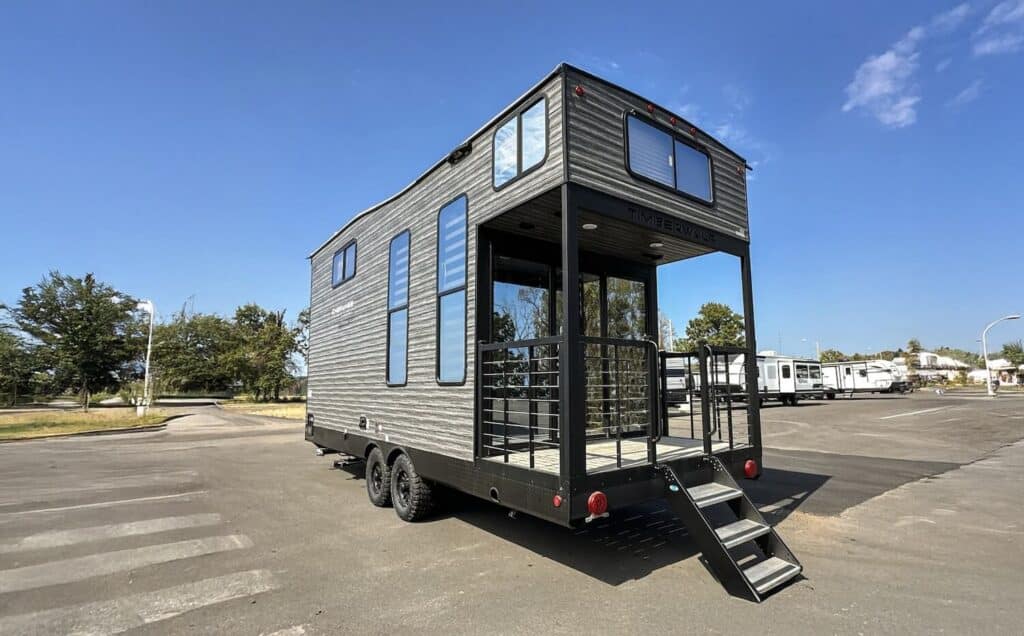
The RVs we’ll feature fall into the destination trailer category. Therefore, we’ll be using “tiny home camper” and “destinational trailer” interchangeably. Some will feature a traditional travel trailer tongue, and others are a newer style that some call “destination-style 5th wheels.” ”
In terms of features, we’ve selected models that offer taller ceilings, multiple bedrooms for comfortable family living, and full kitchens (some including residential appliances like dishwashers and an area prepped for a washer/dryer installation). Some even include built-in outdoor patios or sliding glass doors that make them perfect for building a deck off the campside for a more comfortable outdoor living space. So let’s get into the tiny home vs RV debate!
Tiny House vs RV: Pros and Cons
Both tiny houses and RVs are solutions to compact, simple living. They can both offer reduced housing expenses and overall affordability, but each has specific pros and cons:
Tiny House
Pros
- Can feel more like a house or apartment
- Affordability and reduced cost of living
- Modern amenities
- Eco-friendly and sustainable living
- More customizable than RVs
Cons
- Zoning laws and restrictions
- Financing challenges
- Smaller than many destination trailers
- Not meant to move frequently
RV Tiny Home
Pros
- More portable than tiny houses
- More financing options
- Affordability and reduced cost of living
- Modern amenities
- Larger square footage measurements
Cons
- Less portable than other towable RVs
- Require a heavy-duty truck to tow
- Restrictions at campgrounds
Top Picks for the Best Tiny Home RV
“Compact” means something a little different in this segment, as you’ll find dozens of smaller towable RVs on the market. But, for our classification as a tiny home RV, these models are on the shorter, lighter end of the spectrum for destination trailers—coming in at or under 40 feet.
Timberwolf 16ML
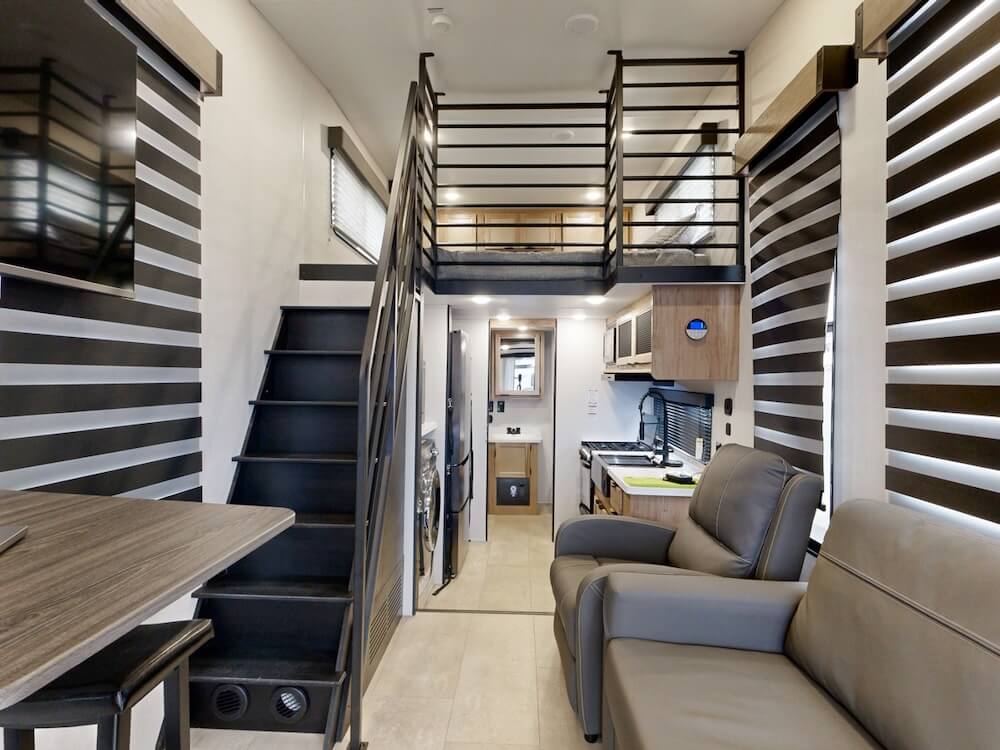
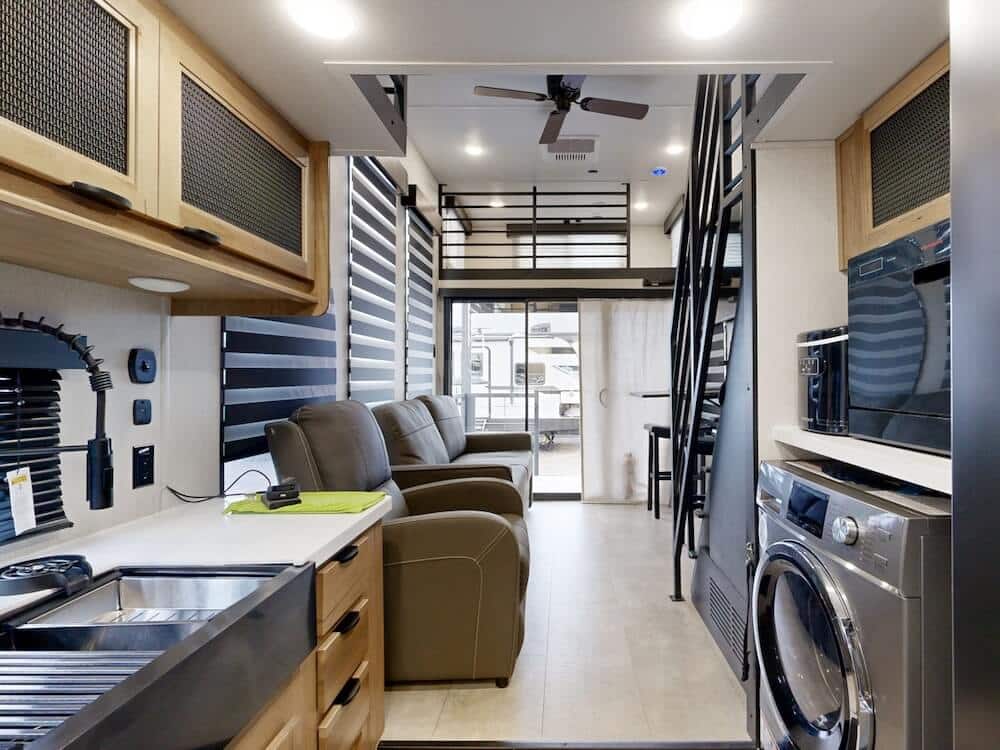
Images by Camping World
Specs
- Length: 27’9”
- Dry Weight: 7,109 pounds
- Cargo Capacity: 4,131 pounds
- Sleeping Capacity: Up to 5
The Timberwolf 16ML is designed similarly to some tiny houses, with a half-story loft above the kitchen and rear bath and extra-high ceilings over the living area. Upstairs, there’s a queen bed, cabinets, and a fireplace, making it a secluded oasis from the rest of the camper. There’s also a smaller second bunk on the opposite side.
Downstairs, you’ll love the back porch, which comfortably seats two people. Large patio doors allow for plenty of natural light, and a high-top table is the perfect spot for dinner. The sofa converts into a third sleeping area—another option if you have an older kid who doesn’t want to sleep in the smaller loft.
The kitchen is fully equipped and has a washer and dryer space. In the rear is the bathroom, which includes a spacious linen closet. The Timberwolf 16ML will make you feel like you’re in a small apartment but tucked away in your favorite campsite.
Forest River makes an identical floor plan in the Campsite Reserve 16SW if you prefer that aesthetic!
Campsite Reserve 20JW
Specs
- Length: 35’8”
- Dry Weight: 8,774 pounds
- Cargo Capacity: 2,431 pounds
- Sleeping Capacity: Up to 7
The Campsite Reserve 20JW has a downstairs bedroom similar to a standard front bedroom in a trailer, with a king bed, overhead cabinets, and side wardrobes. There’s a pass through split bathroom with the shower on one side and the toilet and sink on the other.
The kitchen features a pantry and all the appliances you need, in addition to a washer and dryer space. I also love the flip-up table across from the sofa because it doesn’t take up valuable space unless you’re using it. Large patio doors lead out to a rear porch, the perfect spot for morning coffee or an evening glass of wine.
Upstairs, you’ll find multiple bunk mats for a customizable sleeping area, along with a fireplace and cabinets. It’s a great space for kids to call their own; a hidden retreat when needed. Finally, a second loft on the rear side of the camper can be used for storage or an additional bed.
Forest River makes an identical floor plan in the Timberwolf 20OG if you prefer that aesthetic!
Tiny Home RV Comparisons
- Wildwood Grand Lodge 353FLFB – Two slide-outs make this 37’9” destination trailer feel spacious and homey, and without a loft, you can enjoy high ceilings throughout the camper.
- No Boundaries RVS3 – Another option with two slide-outs, but this tiny home RV has a loft with two bunk mats. A spacious kitchen island, L-shaped lounge, and double bathroom vanity make you feel like you’re at home!
Options for a Larger 5th Wheel Tiny Home
If you prefer the towing experience and overall layout of a 5th wheel, check out these larger tiny home RVs that feature multiple slide-outs, spacious living areas, and gourmet kitchens. However, these are larger, heavier models, so you’ll definitely need a heavy-duty truck for safe towing.
Campsite Reserve 39LA
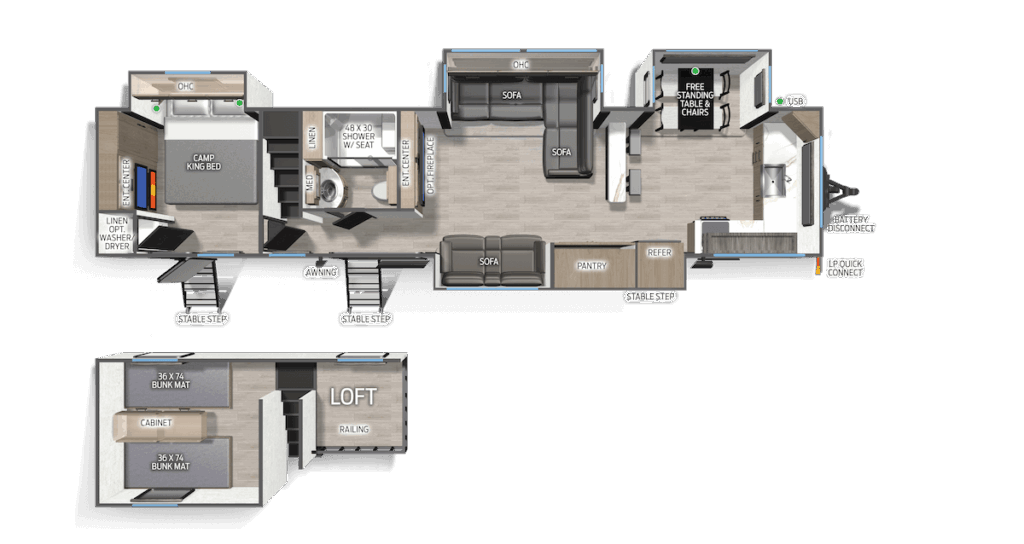
Specs
- Length: 43’9”
- Dry Weight: 12,194 pounds
- Cargo Capacity: 1,806 pounds
- Sleeping Capacity: Up to 8
The Campsite Reserve 39LA features a front kitchen layout perfect for those who enjoy entertaining and cooking. The L-shaped countertop offers plenty of space for meal prep, and the bar seating and nearby dinette make it easy to serve friends. The living space has an L-shaped sectional, a second sofa, an entertainment center with a fireplace, and a huge pantry closet.
Double entries into this fifth wheel tiny home lead to the bathroom and rear bedroom. I love how private the bedroom is, completely separated from the rest of the camper. Upstairs, there are two bunk mats and a play area for smaller children. With the four slide-outs and upscale amenities, this camper offers excellent space and residential comfort!
Salem Grand Villa 42VIEW
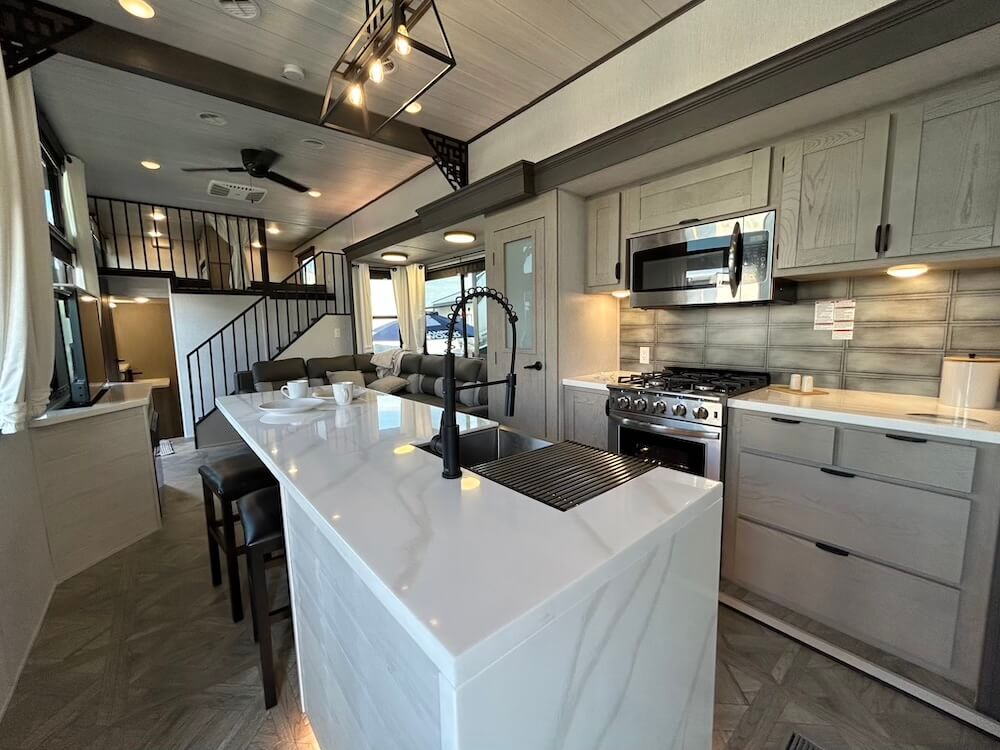
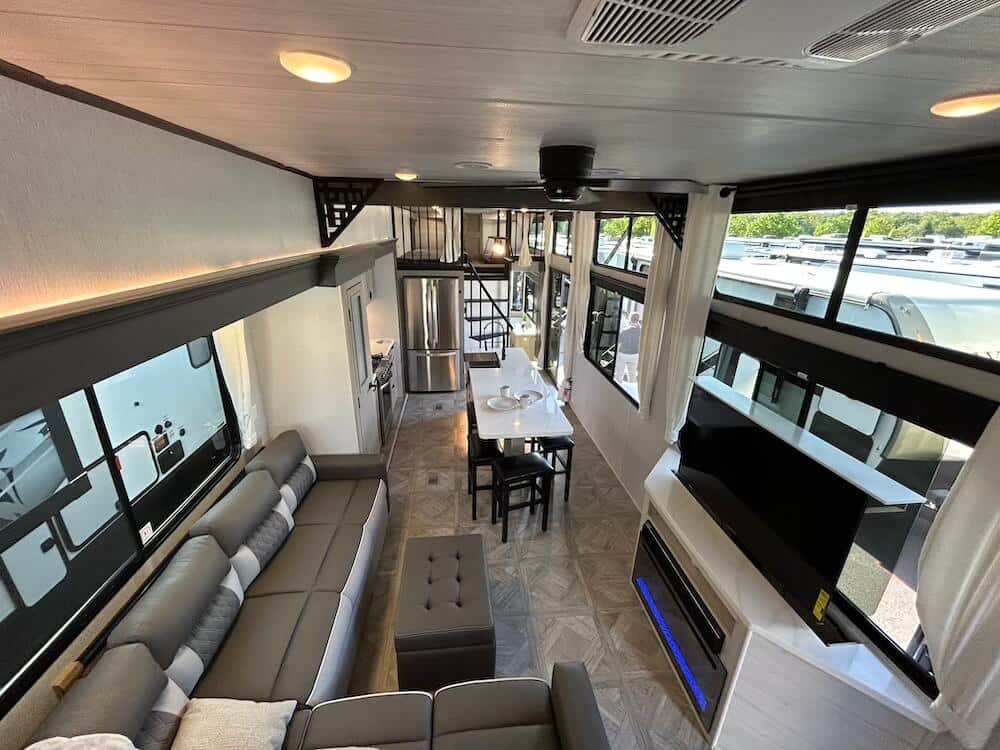
Images by Camping World
Specs
- Length: 45’
- Dry Weight: 13,749 pounds
- Cargo Capacity: 1,996 pounds
- Sleeping Capacity: Up to 8
If you have a family with three or four kids, the Salem Grand Villa 42VIEW has a separate sleeping area for everyone without converting a dinette or sofa. With two separate lofts with bunk mats and a king bed in the downstairs bedroom, everyone has their private space. Other large family features include a central kitchen island with bar seating, a huge L-shaped sectional sofa, and a spacious rear bathroom with a large linen closet and a washer and dryer cubby.
The spiral staircase is a unique highlight and truly makes you feel like you’re in a sticks-and-bricks apartment rather than in an RV tiny home. The super slide along the central living area also creates a comfortable place to lounge as a family and enjoy comfortable camping.
Jay Flight Bungalow JAYLOFT
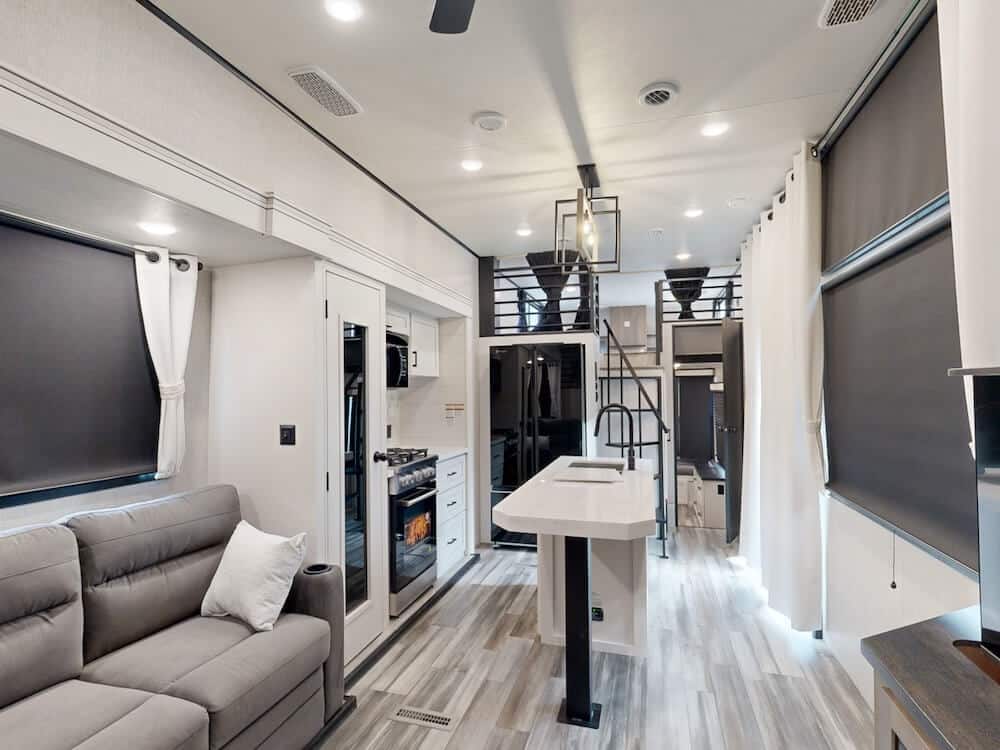
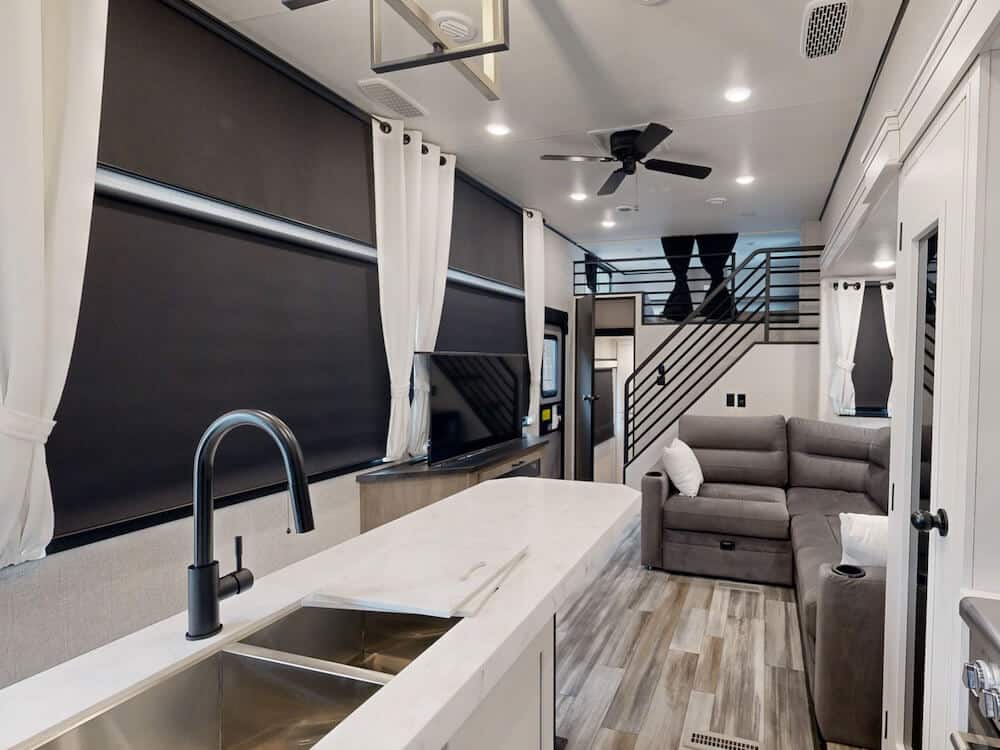
Images by Camping World
Specs
- Length: 41’11”
- Dry Weight: 12,360 pounds
- Cargo Capacity: 1,940 pounds
- Sleeping Capacity: Up to 9
Another family-friendly RV tiny home fifth wheel is the Jay Flight Bungalow JAYLOFT, which features five upstairs bunk mats in the two lofts and a downstairs queen bed. Two of the bunk mats are quite small, though, and suitable for younger children only. But this layout still allows everyone to have their personal sleeping space.
Downstairs, the family will love the large L-shaped sectional sofa and the kitchen island with bar seating. The rear bathroom is comfortable for a family to share, and the entertainment center with a fireplace is the ideal spot for family movie nights. Like the Salem Grand Villa, this RV tiny home features a spiral staircase that will make you the talk of the town!
Larger RV Tiny House Comparisons
- Campsite Reserve 39JD – With two queen bed bunk mats in the loft, this 5th wheel tiny home offers excellent sleeping space for families with older children. The sectional sofa, spacious kitchen, and bathroom double vanity are also family-friendly features.
- Coleman Homestead NOVA – A massive rear bathroom includes an L-shaped countertop, a double vanity, and a washer and dryer cubby. With three separate sleeping spaces, there is room for the whole family.
- Timberwolf Black Label 39DLBL – Featuring a more traditional fifth wheel floor plan with a rear living area and front bedroom, this 5th wheel tiny home also has a loft with two bunk mats and a storage or play area.
- Salem Grand Villa 42VERANDA – This is tiny living at its best with a rear veranda that features an outdoor kitchen!
- Catalina Destination 42CONDO – This 5th wheel is another option for families who need multiple sleeping areas. With a queen bed downstairs and five bunk mats in the two lofts, there is room for everyone.
Can You Park Tiny Homes in RV Parks?
Regulations vary from park to park, so the best answer is to contact campgrounds directly to learn their tiny home rules. However, you certainly have more flexibility and options when towing an RV tiny home (a destination trailer) over a traditionally built tiny house.
In campgrounds that allow RV tiny homes, you might have select sites that accommodate the length of your camper. You might also be assigned a site in a certain area where more permanent guests reside.
Two common rules and regulations about tiny homes in RV parks include age restrictions (such as only allowing campers 10 years old or less) and self-containment (RVs must have their own plumbing, electricity, waste storage, etc).
Learn how to find RV parks without a 10-year rule.
How Much Does a Tiny Home Trailer Cost?
You can buy tiny house prefab kits for around $20,000. However, most people customize and make their tiny home more personal. Building materials and labor average anywhere from $150-450 per square foot for a total cost between $30,000-70,000, depending on size. There’s also the factor of time if you’re completing a DIY build.
On the other side of this tiny home vs RV debate, new destination trailers cost anywhere from $35,000 to over $100,000. While this is roughly the same amount of money, you tend to get more bang for your buck with an RV tiny home since they have more spacious interiors. In addition, these tiny homes are ready to roll off the lot and onto your campsite.
Discover more about The Rise of the Destination Trailer.
What’s the Difference Between a Park Model RV vs a Tiny House?
Park models and tiny houses are similar because they require full hookups and are built for stationary use. Some aren’t even built on a trailer chassis and therefore cannot be towed.
While park models and destination trailers are designed for long-term stays, destination trailers are more mobile and easier to relocate. Because they have holding tanks, these trailers can also boondock—or camp without hookups.
Learn more about park model RVs.
Tiny home RVs offer excellent versatility for RVers looking for a long-term camping option. But, like with any debate, there are pros and cons to tiny homes and tiny home RVs. If you’d like to learn more about stationary living, check out these articles.
- A Guide To Stationary RV Living for Beginners
- Two Story RVs: Bigger, Better, Taller
- What’s the Best Starlink for RV Campers?
- Best Cell Phone Signal Booster for RVs
Do you live in a tiny home seasonal or full-time? We’d love to know your opinion of the tiny home vs RV debate in the comments below!
Author
-

Originally from NC, our family has traveled America since September 2021 in our fifth wheel, visiting 29 states and over 50 national park units. We love the roadschooling adventure, learning more about ourselves, our country, and other cultures. Our favorite memories are at Zion and Acadia, where the sweeping beauty has captured our hearts!
View all posts








